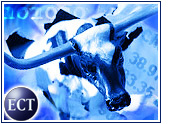
An economic downturn means fewer dollars for salaries, business resources and, unfortunately, research and development. But is a poor economy synonymous with a dip in technical innovation, particularly at bellwether companies like Cisco and IBM?
Not necessarily, according to analysts. “There’s less money across the board, but the dollars that once would have gone into marketing have been put into R&D,” Kent Allen, an analyst with the Aberdeen Group, told the E-Commerce Times. “Most companies’ boards are not demanding that they spend US$1 million a month to build brand.”
During the economy’s nearly two-year slide, technological innovation did not come to a complete standstill. For example, industry giant Intel was able to produce smaller, more powerful chips, and Proxim and Research In Motion took wireless innovation to new heights.
But this economic downturn has been characterized by a more measured approach to innovation, meaning that some Star Wars-like technologies, such as smart cards and artificial intelligence, have languished.
From Anything Goes
When the economy was red hot, every innovative idea came to fruition — regardless of its utility. Just look at Pennsylvania-based e-Vend.net, which installed Internet-connected washing machines in the dormitories of the Massachusetts Institute of Technology (MIT). Students can check washing machine availability online and can receive e-mail alerts from newly vacated machines.
“Wireless was a big area because it was fashionable,” Aberdeen Group analyst Andre Arkhipov told the E-Commerce Times. Vendors worked hard to apply location technology to wireless devices in hopes of stimulating marketing opportunities for e-commerce-driven enterprises.
But the ability to send a 99-cent Big Mac coupon via cell phone to someone about to pass a McDonald’s hardly seems necessary, or even prudent, in a less-than-exuberant economy.
Instead, the focus has shifted to the practical rather than the breathtaking. “On the financial side of the world, there has been a definite shift,” Arkhipov said. “Most companies are looking to streamline processes. They are looking for near-term results. They are not looking for fashionable stuff.”
Practical Magic
Vendors are responding in kind with technology designed to ease enterprise woes rather than with gee-whiz innovations.
Sun Laboratories is one group that has taken up the mantle of practicality, noting on its Web site, “Even though our research may push the boundaries of what is possible, we work hard to keep our development focused on what is practical and profitable.”
There is also a change in who is doing the innovation. “Smaller companies that I cover actually kind of got their technology going in the wake of the downturn,” Allen said. On the whole, he noted, smaller and private companies “have done a better job of forcing R&D” because public companies must meet their financials and have less latitude with budget dollars.
Practical Magic
Technologies left on the back burner during the economic downturn now are beginning to make their way to the forefront, more out of necessity than because of a true economic recovery.
The federal government, dogged by older technologies and an aging workforce, will be spending more on its IT needs — and outsourcing more of them. And while federal dollars represent a small slice of IT spending, the private sector is expected to join in by reviving technologies like smart cards and pushing biometrics even further.
Recent examples include Palm Beach, Florida-based Applied Digital Solutions’ “Verichip,” an implantable device that the company hopes can be used for defense and security purposes; and a deal announced last week by Littleton, Massachusetts-based Viisage to provide its face-recognition technology to the U.S. Army.
Terrorism Spurs Innovation
Yankee Group program manager Andy Efstathiou told the E-Commerce Times that the atmosphere created by the terrorist attacks of September 11th will add to the demand for new technology. “There is an increased interest and increased demand,” he noted.
“I would assume that this type of environment — post-September 11th — would propel the adoption of smart card technology,” Efstathiou added.
Indeed, such technology, which is widely adopted in Europe but lags in the United States, is just one example of an initiative that has been revived in the fight against terrorism.
According to Efstathiou, disaster recovery and business continuity technology and systems also will “be given additional impetus as a result of September 11th.”
Will AI Beat the Hype?
Other innovative technologies also are making progress despite the economic downturn.
Advances in artificial intelligence (AI) eventually could turbo-charge customer analytics, giving companies speedier insights into individual buying patterns and a host of other consumer habits.
AI has gotten a bad rap in the past and has been characterized as too much hype and not enough practical application. But that is about to change, according to the technology’s proponents.
SAS Institute, a privately held software company that specializes in business intelligence, is among the companies studying the use of AI-enhanced data mining.
SAS officials claim that one client, financial services firm Dreyfus, cut its customer attrition rate by more than 40 percent through use of an advanced analytics program, which helped identify and fix problems that were sending customers elsewhere.
Finding Fraud
Anne Milley, director of analytics strategy at SAS, said AI speeds up the analytics process and points users toward deep logical patterns that algorithms alone might not pick up.
“Neural networks go after patterns that might be significant indicators of fraud,” Milley told the E-Commerce Times. The technology holds particular promise for alerting insurance companies to false claims, she said.
Michael Wellman, director of the University of Michigan’s Artificial Intelligence Lab, told the E-Commerce Times that “the state of the science [of AI] and the practice, including application to business, has never been healthier.”
Innovation Ahead
Regardless of the reason, however, the innovation landscape should change soon. IDC research director Stephen Minton and others said they expect a tech recovery could occur as soon as next year, spurred by an improving economy and a need for greater security in the wake of September 11th.
Minton explained that a sluggish economy is not always a bad thing for R&D over the long term. There is some evidence that a downturn often precedes innovation, he noted.
“In a funny kind of way, a downturn is the best thing that can happen to innovation,” he said. “If you look back at the 1980s, it was the crash of the PC stocks and, in the end, everyone was predicting the end of PCs.
“Out of the ruins, there were a lot of companies like Microsoft, Cisco and Compaq that really started to appear and become the huge, global innovators they were over the next 10 years,” Minton added.






















































Great article! The Kent Allen quote, that smaller and private companies are in a better position to lead innovation because of the financial market’s controls on larger companies, is the thesis of my recent book. As this article illustrates, the evidence is starting to accumulate that the thesis is correct.
– Reid Watts